
|   |

|   |
25th Raindrops Dance Festival - Shyamhari Chakra e-mail: shyamhari@yahoo.com Photos courtesy: Uma Dogra August 27, 2015 Rain in Mumbai automatically arouses a sense of awe in all of us. But, in sharp contrast, Raindrops, the annual Indian classical dance festival that turned 25 this year continues to be the much awaited annual affair for the connoisseurs of Mumbai. A brain-child of the city’s most celebrated Kathak exponent Uma Dogra and hosted by her institution - Samved Society for Performing Arts - this festival has been designed to discover, nurture and highlight new talents in the field of Indian classical dances. Indeed, Uma Dogra has aptly titled her festival after the rain that brings hope and freshness to the earth. Twenty-five years ago, she lost her beloved Guru Pandit Durga Lal who died young. In honour of the maestro, she founded Samved Society during the year (1990) and launched two major annual dance festivals - Pt.Durga Lal Festival for the established artistes and Raindrops Festival for the budding - to commemorate the memory of her Guru year after year and decade after decade. Both the festivals as well as her Samved Society had their silver jubilee celebrations this year that coincide with 50 years of journey of Uma Dogra as a dancer. The three-day festival, staged at the familiar Rabindra Natya Mandir mini theatre adjoining the famous Siddhivinayak temple, from July 24 to 26, featured nine young soloists from five dance styles - Kathak, Bharatanatyam, Odissi, Manipuri and Mohiniattam. (This writer wished that the silver jubilee edition of the festival should have the presence of all the eight Indian classical dance styles. However, upon inquiry with the festival directors, I learnt that there were very few applications from these styles and the applicants failed to impress the scrutiny committee for selection of artistes.) On all the three days of the festival, it was raining incessantly. And yet, the dancers and connoisseurs came in large numbers demonstrating the solidarity of the fraternity belonging to different styles and institutions and their sense of respect and responsibility towards the aspiring artistes for whom appreciation and support matters the most at this point of their career. We saw spectators sitting on the floor to witness the concerts. And matching with the pace of the rain outside, there was the rain of recurring rounds of applause from the audience inside the auditorium that was amazing and heart touching. The young dancers were lucky to have the presence of a galaxy of great artistes and eminent personalities in the audience - Mohiniattam exponent Kanak Rele, Manipuri exponent Darshana Jhaveri, fabulous flutist Ronu Majumdar, tabla maestro Nayan Ghosh, theatre personality Nadira Babbar, Bharatanatyam gurus Sandhya Purecha and Deepak Majumdar, Odissi gurus Daksha Mashruwala, Jhelum Paranjape, Ratikant Mohapatra and many more besides well-known dance scholar and historian Sunil Kothari and an incredibly amicable and humble Sekhar Sen, the chairperson of Sangeet Natak Akademi who shared with the aspiring artistes his story of his struggle as a an aspiring artiste in his youth. The festival kicked off with an invocation to Lord Ganesh - Natakuranji Ganapathy - by Mumbai’s budding Mohiniattam dancer Radhika Nair, a post-graduate from Kanak Rele’s well-known Nalanda Dance Research Centre. Although a coincidence, as the dancer entered the stage and started offering her salutations to the gods, the guru, the accompanying musicians and the audience seeking blessings for a smooth show, her Guru Kanak Rele entered the auditorium and occupied the seat just in front of the stage. What better blessing could a very young disciple seek from the guru than her presence! In fact, all the four presentations that Radhika staged were choreographed by Kanak Rele. The padam that followed the invocation number by Iriyaman Tampi for which the eminent K.N. Panicker has composed the music, brought out the emoting potentials inherent in the dancer. The girl in her early 20’s convincingly transformed herself into a doting mother who is marveled at the beauty of her baby that looks brighter than the full moon and sweeter than the honey-like moonlight that falls on him. Even sweeter is the baby’s voice than the sweet singing of the cuckoo! Is he Lord Krishna! She asks herself as she prays to the Lord for luck for her baby. Radhika’s entry to the stage could have been more appealing by entering from the wings with the portrayal of the scene, holding the baby in her hands, than walking on to the centre of the stage and standing there for the music to commence and her action to unfold. The next number was a treat for the ears as well as for the eyes. It was a fantastic combination of jatis and swaras - the rhythms and the melody - magically crafted by the nattuvangam artiste and the percussionist. Radhika concluded her concert with a brief and neat fast-paced pure dance number. 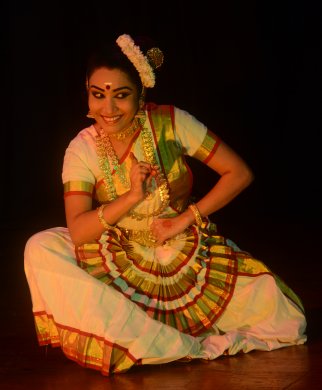 Radhika Nair 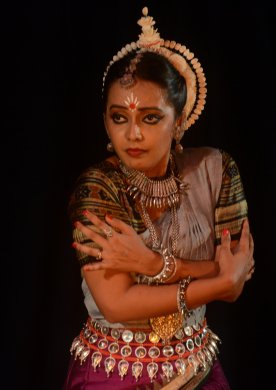 Namrata Gupta Mumbai’s Odissi dancer Namrata Gupta was the greatest pleasant surprise to this writer who hails from the land of Odissi and has been keenly watching the Odissi scene for nearly two decades. I wondered why this immensely gifted dancer is not being seen and discussed more at the national and international Odissi circuits! Confident and sweet, Namrata lucidly explained the compositions that she was about to perform. She commenced her concert with Barsha pallabi, a pure dance number, delineating the joyous moods of the rain and also of the dancer who is thrilled with the fall of the raindrops on her. Unique were the subtle facial expressions of the dancer as she enacted the feelings of the first touch of rain on the face. Namrata won hearts in her next presentation Navarasa in Nature, a touching choreography by her Guru Daksha Mashruwala that draws actions and incidents from the nature that evoke the nine sentiments (navarasa). Although several choreographies are being attempted with the theme of navarasa in various dance styles, this piece was touching in its treatment. It was a clear departure from the conventional way of drawing incidents from mythology to depict the nine sentiments and scenes from the contemporary life were incorporated. An example shall suffice: karunya rasa is evoked when trees were being chopped off killing the beautiful and innocent butterflies. Spontaneous, sculpturesque and sensuous, Namrata excelled both in her exploration of body kinetic and intense emoting. She received the best support from the live orchestra - Vijay Tambe on flute, Agnimitra on violin, G Ram Prasad on mardal and vocalists Manoj Desai and Jatin Sahu. US-based Kathak dancer Rina Mehta’s concert was an emotive tribute to her Guru Pandit Chitresh Das who passed away recently. The highlight of her presentation was her duet - rather a decent duel - with the young tabla artiste Satyaprakash set to 13 beats. “My Guru loved taking risks on stage and I am doing that today with Satyaprakash as a tribute to my Guru,” the dancer stated prior to performing. 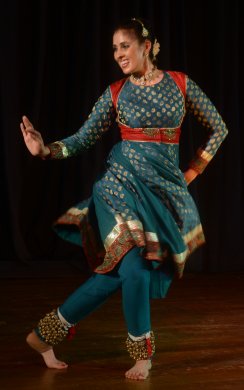 Rina Mehta 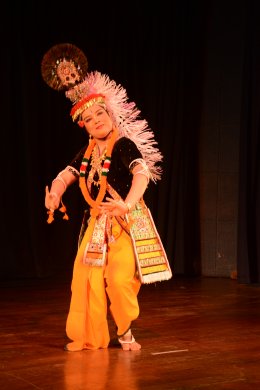 Shreya Ayyub Mumbai’s Manipuri dancer Shreya Ayyub disappointed this reviewer. While her Guru Darshana Jhaveri’s explanation of the compositions she performed was helpful for the audience, the guru reading out the disciple’s bio data appeared weird. Shreya commenced her concert with the invocatory Krishna Stutee that was followed by a brilliant choreographic piece Brahma taal prabandha that ranged from four to 28 beats while concluding with an astapadi from Jayadeva’s Geet Govind followed by Telana (like the Tillana in Bharatanatyam). The joy of dancing was hardly manifested on the dancer’s face. There was very little use of the eyes and the face in emoting the sentiments. And in absence of live orchestra - it was recorded music - it appeared as if the dance pieces ended abruptly. Even the dancer entered the stage before the anchor (Darshana Jhaveri) exit from the stage after explaining the astapadi! The evening belonged to the very young Vishal Krishna, grandson of the legendary Sitara Devi who had taught him the alphabets of Kathak, belonging to the 11th generation of the illustrious family of Benaras gharana. He literally stormed the stage and hooked his audience to their chairs throughout the concert with his unbound energy, unspoiled innocence, intensely involved and spontaneous dancing. And he knows how to hold on to his audience, both with his articulate art of dancing and speaking. With his very brief but electrifying invocatory presentation - Om Namah Sivaya - Vishal created an instant rapport with his audience the moment he entered the stage. Then, in his presentation of pure dance aspects of Kathak, he exhibited his grip over the technical elements. Amazing was his control over the spectacular spins that he performed. Moving on, he proved his inherent talent in expressional elements of dancing as he performed the very popular Meera Bai composition Jhuki Aayi Badariya Saawan Ki. As he was articulating the feel of the raindrops, one forgot that it was mere mime - such was the involvement and expression! He then produced the sound of the rain with very delicate movements of his ankle bells that astounded the audience. Finally, he brought magic on stage with the rarely seen thali dance (dancing on the brim of a brass plate like the Kuchipudi repertoire) that has been the exclusive legacy of the Benaras gharana (that Vishal informed). As Vishal concluded his captivating concert while the ecstatic audience was not in a mood to bid him a bye or stop clapping, visibly moved Uma Dogra and Sunil Kothari went on the stage to greet the budding and highly promising dancer. “Vishal, you reminded me of what Sitara Devi used to say - aandhi ki tarah aao aur toophan ki tarah jao” (come like a typhoon and go like a storm), said Sunil Kothari while Uma Dogra added, “Hum Kathak ke log hai aur hum mehfil banana bahut pasand karte hein” (we, the Kathak people, love to create such intimate concerts). Vishal must have felt blessed with such profound compliments from such stalwarts! 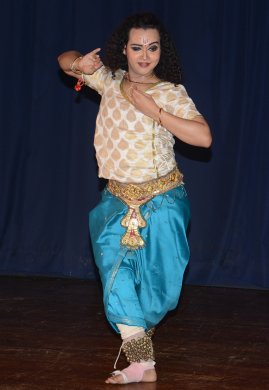 Vishal Krishna 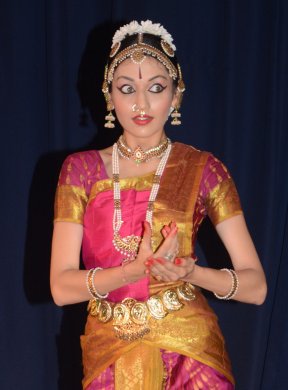 Suhani Dhanki Budding Bharatanatyam dancer Suhani Dhanki from Mumbai, disciple of the city’s well-known scholarly Guru Sandhya Purecha, was able to arrest the attention of the audience despite her predecessor’s power-packed performance. The youngest dancer in the festival - a gold medalist from Bharata College of Fine Art and Culture of Mumbai - who aspires to be a lawyer while pursuing her passion for dance, her lively performance was the dance of sheer delight and perfection. In judicious exploration of the stage-space, she was the best amongst all the performers in the festival. Suhani commenced her concert with an apt invocation set to an equally apt ambience. As she was performing the beautifully composed Sapta Tandav by her Guru, the unique seven kinds of tandav dance of the God of dance - Lord Shiva - her guru was conducting the concert seated to her right while the idol of Lord Nataraj was placed to her left on the stage. The Varnam, Madhurastakam, Tillana and Mangalam that followed in her neat concert were her guru’s choreographies who conducted the concert and lucidly explained the background of the dance numbers and the dancer as well. At a relatively young age, Anuj Mishra, son and disciple of Pandit Arjun Mishra from Lucknow, became a sensation among the budding and promising Indian classical dancers. I remember watching this handsome and gifted Kathak dancer with a sense of wonder exactly a decade ago in Mumbai’s famed Kal Ke Kalakar dance festival where he had emerged as the star of the festival that year. And Anuj has, in the meanwhile, been duly conferred the coveted Ustad Bismillah Khan Yuva Prativa Puraskar of the Sangeet Natak Akademi that is the national award for young dancers of India. He, however, failed to live up to his reputation and our expectations. With unwarranted ornamentation, his body appeared heavy. He had a headgear (to establish the identity of Krishna) in his invocatory presentation - Shyam murat man bhae. He also wore a heavy waist-band and a heavy necklace. I wondered if it was essential to look like the mythical Krishna to establish the character! If so, the dancer might be required to hold a flute in his hands next time! How often do we watch legendary Birju Maharaj, belonging to the same Lucknow gharana, enacting the character of Krishna and without decorating the body as Krishna! And violating the stage mannerism, Anuj took off the headgear and the necklace on stage after presenting the Krishna number that he could have done backstage before being back for the next presentation of pure dance numbers. It appears that the immensely talented dancer relies more on exhibition of his body kinetic than the gradual unfolding of his inner-self and the characters through bhav (the emoting). Thus we witnessed repetitive rounds of spins during the concert. However, Anuj’s on-stage duel with his percussionist, tabla maestro Pandit Kalinath Mishra, was a treat for the connoisseurs. It was a friendly fight between the dancer’s feet and the percussionist’s fingers on tabla - a perfect jugalbandi. Set to his father Pandit Arjun Mishra’s composition - who was conducting the concert for his son / disciple - Anuj performed 16 spins thrice in quick succession in three different speeds with effortless ease - a rare feat indeed. 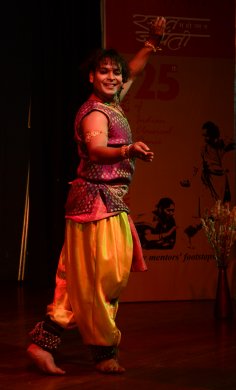 Anuj Mishra 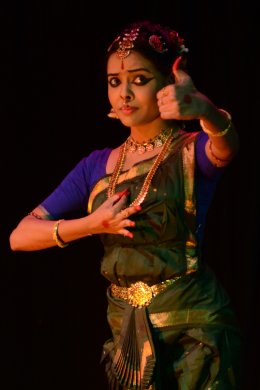 Mrinalini Biswas Kolkata’s talented and passionate Bharatanatyam dancer Mrinalini Biswas - who was trained under legendary Yamini Krishnamurthy earlier and who has a proven track record of performing with perfection - missed the rare opportunity of proving her talent in far off Mumbai dance circuit. It was recorded music and the sound of the percussion was not being heard properly. As a result, she was missing the taal (rhythmic patterns), despite her excellent execution of the sancharis (elaboration of expressions and the story) coupled with tastefully adorned costumes and make up and clear postures and neat expressions. Unlike all her predecessors, who divided their concert into several shorter pieces, she had chosen one varnam that revolved round the interesting dialogue between Lord Shiva and his son Muruga who becomes the father’s guru by teaching him the precious Pranav mantra. 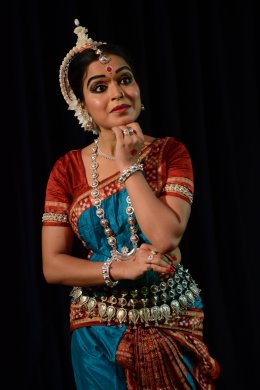
Rajashri Praharaj
Odissi dancer from Odisha, Rajashri Praharaj, the last performer of the last evening left a lasting imprint in the memories of her audience. And she won a standing ovation - the only one to receive such a rare gesture of admiration. Trained under the watchful eyes of Guru Ratikant Mohapatra, Rajashri, known for her determination and hard work, staged a captivating presentation of legendary Guru Kelucharan Mohapatra’s composition of Sita-haran (Abduction of Sita) from the Ram Charit Manas. Despite being short in stature and slim, she could incredibly and convincingly transform her body language to suit the gait and character of the ferocious Ravana, the dignified Rama, the fierce fighter Jatayu, the dancing golden deer, the confused Laxman and the lamenting Sita - all with effortless ease. It was, indeed, a fitting finale to the festival that was conceptualized to discover and nurture new talents at the national level. In fact, in 25 years of its journey, Raindrops Festival has presented more than 200 young dancers, many of whom have become stars and stalwarts later in their careers. The closing ceremony was an emotive get-together of many of the great artistes and eminent personalities on stage - from Sekhar Sen, Nadira Babar and Sailendra Bharati to Mandakini Trivedi, Daksha Mashruwala and Deepak Majumdar as a mark of their solidarity with and gratitude for host Uma Dogra who not only dreamt a classical dance festival for the aspiring artistes in the commercial city of Bombay and Bollywood a quarter century ago but also could carry it forward as a major event in Mumbai’s annual cultural calendar. After curtains came down on the final evening of the festival and the audience, the artistes and the dignitaries left the auditorium, I found the two unsung hosts of the successful event still running around to ensure that everything ends up well. They were Uma Dogra’s most trusted and dependable disciples (and Raindrops Festival’s directors for the past few years) Indrayanee and Suhani (Uma Dogra’s journalist-daughter), who were like her two hands - handling everything from selection of artistes to anchoring the event and attending to anyone entering the auditorium. A former journalist with Indian Express and The Hindu for nearly 20 years in Odisha, Shyamhari Chakra is currently based in New Delhi as an independent writer on dance matters. He has been awarded the Senior National Fellowship by the Ministry of Culture to conduct research on Odissi dance. |